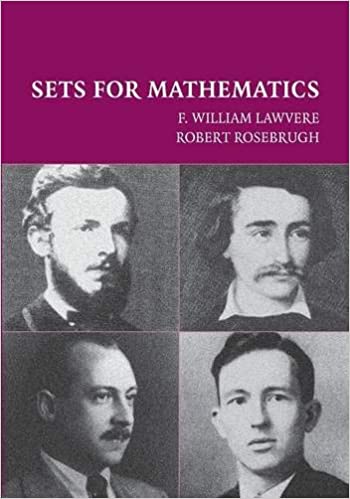
This article is a stub. You can help us by
editing this page and expanding it.
| Basic Mathematics
|

|
| Information
|
| Author
|
F. William Lawvere
|
| Language
|
English
|
| Publisher
|
Cambridge University Press
|
| Publication Date
|
10 April 2003
|
| Pages
|
276
|
| ISBN-10
|
0521010608
|
| ISBN-13
|
978-0521010603
|
The textbook Sets for Mathematics by F. William Lawvere uses categorical algebra to introduce set theory.
Table of Contents
| Chapter/Section # |
Title |
Page #
|
| Foreword |
ix
|
| Contributors to Sets for Mathematics |
xiii
|
| 1. Abstract Sets and Mappings
|
| 1.1 |
Sets, Mappings, and Composition |
1
|
| 1.2 |
Listings, Properties, and Elements |
4
|
| 1.3 |
Surjective and Injective Mappings |
8
|
| 1.4 |
Associativity and Categories |
10
|
| 1.5 |
Separators and the Empty Set |
11
|
| 1.6 |
Generalized Elements |
15
|
| 1.7 |
Mappings as Properties |
17
|
| 1.8 |
Additional Exercises |
23
|
| 2. Sums, Monomorphisms, and Parts
|
| 2.1 |
Sum as a Universal Property |
26
|
| 2.2 |
Monomorphisms and Parts |
32
|
| 2.3 |
Inclusion and Membership |
34
|
| 2.4 |
Characteristic Functions |
38
|
| 2.5 |
Inverse Image of a Part |
40
|
| 2.6 |
Additional Exercises |
44
|
| 3. Finite Inverse Limits
|
| 3.1 |
Retractions |
48
|
| 3.2 |
Isomorphism and Dedekind Finiteness |
54
|
| 3.3 |
Cartesian Products and Graphs |
58
|
| 3.4 |
Equalizers |
66
|
| 3.5 |
Pullbacks |
69
|
| 3.6 |
Inverse Limits |
71
|
| 3.7 |
Additional Exercises |
75
|
| Colimits, Epimorphisms, and the Axiom of Choice
|
| 4.1 |
Colimits are Dual to Limits |
78
|
| 4.2 |
Epimorphisms and Split Surjections |
80
|
| 4.3 |
The Axiom of Choice |
84
|
| 4.4 |
Partitions and Equivalence Relations |
85
|
| 4.5 |
Split Images |
89
|
| 4.6 |
The Axiom of Choice as the Distinguishing Property of Constant/Random Sets |
92
|
| 4.7 |
Additional Exercises |
94
|
| 5. Mapping Sets and Exponentials
|
| 5.1 |
Natural Bijection and Functoriality |
96
|
| 5.2 |
Exponentiation |
98
|
| 5.3 |
Functoriality of Function Spaces |
102
|
| 5.4 |
Additional Exercises |
108
|
| 6. Summary of the Axioms and an Example of Variable Sets
|
| 6.1 |
Axioms for Abstract Sets and Mappings |
111
|
| 6.2 |
Truth Values for Two-Stage Variable Sets |
114
|
| 6.3 |
Additional Exercises |
117
|
| 7. Consequences and Uses of Exponentials
|
| 7.1 |
Concrete Duality: The Behavior of Monics and Epics under the Contravariant Functoriality of Exponentiation |
120
|
| 7.2 |
The Distributive Law |
126
|
| 7.3 |
Cantor's Diagonal Argument |
129
|
| 7.4 |
Additional Exercises |
134
|
| 8. More on Power Sets
|
| 8.1 |
Images |
136
|
| 8.2 |
The Covariant Power Set Functor |
141
|
| 8.3 |
The Natural Map \(Placeholder\) |
145
|
| 8.4 |
Measuring, Averaging, and Winning with \(V\)-Valued Quantities |
148
|
| 8.5 |
Additional Exercises |
152
|
| 9. Introduction to Variable Sets
|
| 9.1 |
The Axiom of Infinity: Number Theory |
154
|
| 9.2 |
Recursion |
157
|
| 9.3 |
Arithmetic of \(N\) |
160
|
| 9.4 |
Additional Exercises |
165
|
| 10. Models of Additional Variation
|
| 10.1 |
Monoids, Podsets, and Groupoids |
167
|
| 10.2 |
Actions |
171
|
| 10.3 |
Reversible Graphs |
176
|
| 10.4 |
Chaotic Graphs |
180
|
| 10.5 |
Feedback and Control |
186
|
| 10.6 |
To and from Idempotents |
189
|
| 10.7 |
Additional Exercises |
191
|
| Appendixes
|
| A. Logic as the Algebra of Parts
|
| A.0 |
Why Study Logic? |
193
|
| A.1 |
Basic Operators and Their Rules of Inference |
195
|
| A.2 |
Fields, Nilpotents, Idempotents |
212
|
| B. Logic as the Algebra of Parts |
220
|
| C. Definitions, Symbols, and the Greek Alphabet
|
| C.1 |
Definitions of Some Mathematical and Logical Concepts |
231
|
| C.2 |
Mathematical Notations and Logical Symbols |
251
|
| C.3 |
The Greek Alphabet |
252
|
| Bibliography |
253
|
| Index |
257
|

